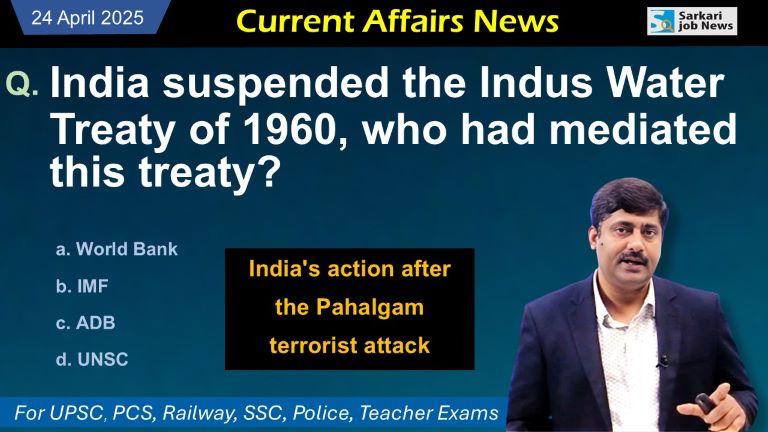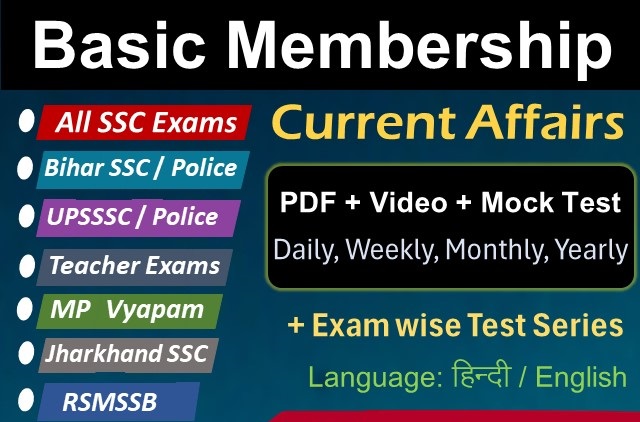This is the current affairs of 24 April 2025. Here are questions and answers of daily current affairs for better preparation of competitive exams for government jobs.
PDF Download: Click here
1. On whose death did the Government of India declare three days of state mourning in April 2025 and lowered the Flag across the country?
a. Actor Manoj Kumar
b. Dadi Ratanmohini
c. Pope Francis
d. 26 people killed in Pahalgam terrorist attack
Answer: c. Pope Francis

– Pope Francis Passes Away on April 21, 2025
– Pope Francis passed away on April 21, 2025.
– Francis, who was the first non-European pope in nearly 1,300 years, died on Monday. He was 88 years old.
– The Indian Ministry of Home Affairs has declared a three-day state mourning in honor of Pope Francis’s demise.
Three-Day State Mourning in India
– In a statement, the Ministry of Home Affairs said, “His Holiness Pope Francis, the Supreme Pontiff of the Holy See, passed away on April 21. As a mark of respect, a three-day state mourning will be observed throughout India.”
– According to the schedule, a two-day state mourning will be observed on April 22 (Tuesday) and April 23 (Wednesday). Additionally, a one-day state mourning will be observed on the day of the funeral.
– During the period of state mourning, the national flag will be flown at half-mast on all buildings across India where it is regularly hoisted, and there will be no official entertainment, the statement added.
—————
2. After the Pahalgam terrorist attack, the Indian government took 5 major decisions including suspending the Indus Water Treaty with which country?
a. Bangladesh
b. China
c. Sri Lanka
b. Pakistan
Answer: d. Pakistan
– Following the Pahalgam Terror Attack on April 22, 2025, Which Killed 26 People, the Cabinet Committee on Security (CCS) Took 5 Major Decisions on April 23
What is CCS?
– The Cabinet Committee on Security (CCS) is India’s highest decision-making body on matters of national security.
– The Prime Minister chairs the committee. Its members include the Defence Minister, Home Minister, Finance Minister, and External Affairs Minister.

Key Decisions Taken by the Cabinet Committee on Security (CCS):
1. Suspension of the Indus Waters Treaty until Pakistan stops supporting cross-border terrorism.
2. Immediate closure of the Attari-Wagah check post. Those who have already crossed legally must return before May 1.
3. Pakistani nationals will no longer be allowed entry into India under the SAARC visa exemption scheme. All previously issued visas will be canceled. Pakistani nationals currently in India on such visas must leave within 48 hours.
4. Defence and military advisors posted at the Pakistani High Commission in Delhi must leave India within a week. These positions will be abolished. India will also recall its own defence advisors from Islamabad.
5. Reduction in diplomatic staff at both the Indian and Pakistani High Commissions from 55 to 30. This reduction will take effect from May 1, 2025.
What is the SAARC Visa Exemption Scheme?
– The South Asian Association for Regional Cooperation (SAARC) was established on December 8, 1985, with the signing of the SAARC Charter in Dhaka.
– At the fourth summit held in Islamabad in December 1988, it was decided that certain categories of prominent individuals from SAARC countries should be entitled to a special travel document that would allow them visa-free travel within the region.
The SAARC Visa Exemption Scheme was launched in 1992.
– Currently, the scheme covers 24 categories of eligible individuals, including dignitaries, judges of higher courts, Members of Parliament, senior officials, businessmen, journalists, athletes, and others.
– SAARC currently comprises eight member countries: Afghanistan, Bangladesh, Bhutan, India, Maldives, Nepal, Pakistan, and Sri Lanka.
– Visa stickers are issued by the respective member countries to eligible individuals.
– The validity of these visa stickers for eligible categories in a particular country is generally one year.
– Immigration authorities of SAARC member countries regularly review the implementation of this scheme.
————-
3. After the Pahalgam terror attack, India suspended the 1960 Indus Water Treaty, who had mediated this treaty?
a. World Bank
b. IMF
c. ADB
d. UNSC
Answer: a. World Bank
– After the Pahalgam terrorist attack (April 22, 2025), India dealt a blow to Pakistan by suspending the Indus Waters Treaty.
What is the Indus Waters Treaty?
– In September 1960, India and Pakistan signed the Indus-Tas agreement with the mediation of the World Bank. It is called the Indus Waters Treaty or Sindhu Jal Sandhi.
– The then Prime Minister of India, Pandit Jawaharlal Nehru, and the then President of Pakistan, Ayub Khan, signed the agreement.
– Under this agreement, the control of the western rivers—Jhelum, Indus, and Chenab—was given to Pakistan, and it has the right to 80% of the water from these rivers. India has the right to generate electricity from the flowing water of these rivers but does not have the right to stop the water or change the course of the rivers.
– The control of the eastern rivers—Ravi, Sutlej, and Beas—is with India, and it can build hydroelectric and other projects on these rivers.
What are the provisions in this treaty?
– Under the agreement, a permanent Indus Commission was established. Under this, the Indus Commissioners of both countries will hold discussions among themselves on any disputes.
– If any country starts a hydro project on the rivers and the other country has an objection to it, then it must respond. The commission will hold meetings on this and both countries will resolve the issue.
– In case of a dispute, the matter can be taken to a neutral expert or a court of arbitration, which will resolve the issue.
What was the purpose of the agreement?
– The purpose of the Indus Waters Treaty was that there should be no conflict between the two countries over water and that agriculture should not be hindered.
– However, India has always respected this treaty, while Pakistan has repeatedly been accused of supporting terrorism.
– India has fought three wars with Pakistan, but India never stopped the water, while Pakistan has always been responsible for terrorist attacks in India.
Impact of Suspending the Indus Waters Treaty
– About 90% of agricultural land in Pakistan, i.e., 47 million acres, receives irrigation water from the Indus river system. The agriculture sector contributes 23% to Pakistan’s national income and supports the livelihood of 68% of rural Pakistanis.
– Pakistan’s Mangla and Tarbela hydropower dams will not receive water. This could result in a 30% to 50% reduction in Pakistan’s electricity generation. Additionally, it will impact industrial production and employment.
– In such a scenario, along with the general public, Pakistan’s already struggling economy could worsen further.
– Experts say that this cannot be done overnight just by building dams and storing water. About 80% of the entire Indus water system lies in the western rivers. Suddenly stopping this water could also create flood situations in parts of Punjab and Jammu & Kashmir in India.
Will India Really Stop the Water?
– It is not possible to stop the water immediately.
– In fact, to stop or divert the flow of river water, infrastructure such as dams, hydro power projects, or other preparations would need to be developed.
– India has already built projects on the eastern rivers—Bhakra Nangal Dam on the Sutlej, Pong Dam on the Beas, Ranjit Sagar Dam on the Ravi, and projects like Harike Barrage and Indira Canal. All these projects are operational, through which India uses most of the 33 million acre-feet of water from these rivers.
– After the Uri terrorist attack in 2019, India had said that it would divert the flow of these rivers to use 100% of the water domestically. Following that, Shahpur Kandi Project on the Ravi, the Sutlej-Beas Link Canal Project, and the Ujh Dam on a tributary of the Ravi are being constructed. However, these projects are not yet fully completed.
– Meanwhile, India is constructing hydro power projects on the western rivers Jhelum and Chenab.
Kishanganga Hydropower Project
– Kishanganga, or Neelum (as called in Pakistan), is a tributary of the Jhelum River.
– India has built a run-of-the-river hydroelectric project with a capacity of 330 megawatts on this river in Jammu and Kashmir.
Ratle Hydropower Project
– This is a run-of-the-river project being built on the Chenab River in the Kishtwar district of Jammu and Kashmir.
– In 2013, the Pakistan government objected to this project, claiming that it was a violation of the Indus Waters Treaty.
– In 2017, the World Bank allowed India to proceed with the project, despite Pakistan’s opposition.
What is the dispute over Kishanganga and Ratle Projects?
– Due to the provision in the Indus Waters Treaty (regarding western rivers), India designed the Ratle and Kishanganga projects as run-of-the-river projects.
– In the operation of run-of-the-river hydropower, reservoirs are not built for the purpose of water storage. Instead, the natural flow of water from height is used to drive small turbines for electricity generation.
– However, in recent years, Pakistan has objected to this and took the matter to the Permanent Court of Arbitration (PCA) in The Hague, Netherlands. India has continued to oppose this move.
Can India Exit the Indus Waters Treaty?
– The Indus Waters Treaty is a permanent agreement. No country can unilaterally terminate it. Both countries must agree to any changes.
– However, Article 12(4) of this treaty describes the process for terminating the agreement.
– To terminate this treaty, both countries would need to draft a proposal.
– Both countries would have to sign it.
– However, strategy analyst Brahma Chellani says that under Section 62 of the Vienna Convention on the Law of Treaties, India can withdraw from the treaty on the grounds that Pakistan is using terrorist groups against India. The International Court has also stated that any treaty can be terminated if there is a significant change in circumstances.
————–
4. When is National Panchayati Raj Day celebrated?
a. 21 April
b. 22 April
c. 23 April
d. 24 April
Answer: d. 24 April
– Former Prime Minister Manmohan Singh declared the first National Panchayati Raj Day on April 24, 2010.
Panchayati Raj
– This day is celebrated in memory of the implementation of the 73rd Constitutional Amendment Act of 1992 in 1993.
– This Act grants constitutional status to Panchayati Raj Institutions (PRIs) and gives them the right to function as local self-governance institutions at the grassroots level.
– The Panchayati Raj system was first implemented in Rajasthan on October 2, 1959.
– After this, Andhra Pradesh also adopted this system.
– The Indian Constitution recognizes panchayats as institutions of self-governance.
– Currently, there are about 2.63 lakh panchayats and approximately 31.47 lakh elected representatives (ERs) in PRIs.
– Of these, 14.54 lakh (approximately 46.20%) are women.
– This day also highlights the importance of decentralization of power.
————–
5. Which state government withdrew its decision to make Hindi a compulsory language in schools under the Three Language Policy in April 2025?
a. Maharashtra
b. Uttar Pradesh
c. Rajasthan
d. Madhya Pradesh
Answer: a. Maharashtra
– Maharashtra Chief Minister Devendra Fadnavis stated on April 22, 2025, that students will be able to choose their third language freely. Hindi will not be compulsory.
– Education Minister Dadaji Bhuse said that Marathi will be mandatory, English will be the second language, and the third language will be optional.
– The Maharashtra government had issued a Government Resolution (GR) on April 16, 2025, which made Hindi the third language.
– This decision was applied to all Marathi and English medium schools in the state.
– Now, the Three Language Policy will be implemented phase-wise.
– From the next academic year, first-grade students in the state will learn three languages.
– Capital: Mumbai
– Governor: Chandra Prabha Ponnusamy Radhakrishnan
– Language: Marathi
– Population: 110 million (2011)
– Neighboring States: Goa, Karnataka, Telangana, Chhattisgarh, Madhya Pradesh, Gujarat.
—————
6. When is English Language Day celebrated?
a. 24 April
b. 23 April
c. 22 April
d. 21 April
Answer: b. 23 April
– The United Nations (UN) celebrates English Language Day every year on April 23.
– This day is observed as both the birthdate and death date of William Shakespeare.
– Shakespeare was the most famous playwright in the English language and had a significant impact on modern English.
– English is the most widely spoken language in the world.
—————
7. When is Spanish Language Day celebrated?
a. 24 April
b. 23 April
c. 22 April
d. 21 April
Answer: b. 23 April
– This day has been declared by the United Nations.
– After English and Chinese, Spanish is now the third most popular language on the internet.
————–
8. Which player was chosen as the World Sportsman of the Year according to the Laureus World Sports Awards 2025?
a. Jiang Yuyan
b. Real Madrid
c. Rafael Nadal
d. Mondo Duplantis
Answer: d. Mondo Duplantis
– The Laureus World Sports Awards are also known as the Oscars of Sports.
– The 25th anniversary ceremony of this award took place on April 21, 2025, in the capital of Spain, Madrid.
– Swedish 25-year-old Mondo Duplantis won the World Sportsman of the Year award.
– Duplantis became the second track-and-field athlete to win this prestigious award, after four-time winner Usain Bolt.
Laureus World 2025 Award List
– World Sportsman of the Year: Mondo Duplantis
– World Sportswoman of the Year: Simone Biles
– World Team of the Year: Real Madrid
– Breakthrough of the Year: Lamine Yamal
– Comeback of the Year: Rebeca Andrade
– Sportsperson with a Disability: Jiang Yuyan
– Action Sportsperson of the Year: Tom Pidcock
– Sport for Good Award: Kick4Life
– Sporting Icon Award: Rafael Nadal
– Lifetime Achievement Award: Kelly Slater
—————-
9. Which player was given the Laureus World Sportswoman of the Year 2025 award?
a. Nadia Comencey
b. Aitana Bonmati
c. Dipa Karmakar
d. Simone Biles
Answer: d. Simone Biles
– Simone Biles is an American gymnast.
– She received the World Sportswoman of the Year award for the fourth time.
– With this, she tied the record of Serena Williams.
– After taking some time off from competition, Simone Biles won three gold and one silver medal at the Paris Olympics.
Laureus World 2025 Award List
– World Sportsman of the Year: Mondo Duplantis
– World Sportswoman of the Year: Simone Biles
– World Team of the Year: Real Madrid
– Breakthrough of the Year: Lamine Yamal
– Comeback of the Year: Rebeca Andrade
– Sportsperson with a Disability: Jiang Yuyan
– Action Sportsperson of the Year: Tom Pidcock
– Sport for Good Award: Kick4Life
– Sporting Icon Award: Rafael Nadal
– Lifetime Achievement Award: Kelly Slater
—————-
10. Who was appointed as the interim President of the World Economic Forum (WEF) after the resignation of Klaus Schwab?
a. Rajesh Joshi
b. Roger Binny
c. Peter Brabeck-Letmathe
d. None of these
Answer: c. Peter Brabeck-Letmathe (Former Chairman and CEO of Nestle SA)
– Klaus Schwab was the founder and chairman of the World Economic Forum (WEF). He announced his resignation from the position in April 2025.
– Peter Brabeck-Letmathe, the former Chairman and CEO of Nestlé S.A., has been appointed as the interim chairman.
About the World Economic Forum
– The World Economic Forum (WEF) is an international non-profit organization that works to promote dialogue, collaboration, and solutions on global economic issues.
– It was founded in 1971 by Klaus Schwab in Geneva, Switzerland.
– The headquarters is located in Cologny, Switzerland.
– Every year, in January, it is held in Davos, Switzerland.
– It brings together top leaders, policymakers, businesspeople, intellectuals, journalists, and social activists from around the world.
– Discussions at the forum focus on global economic, social, environmental, and technological issues.




